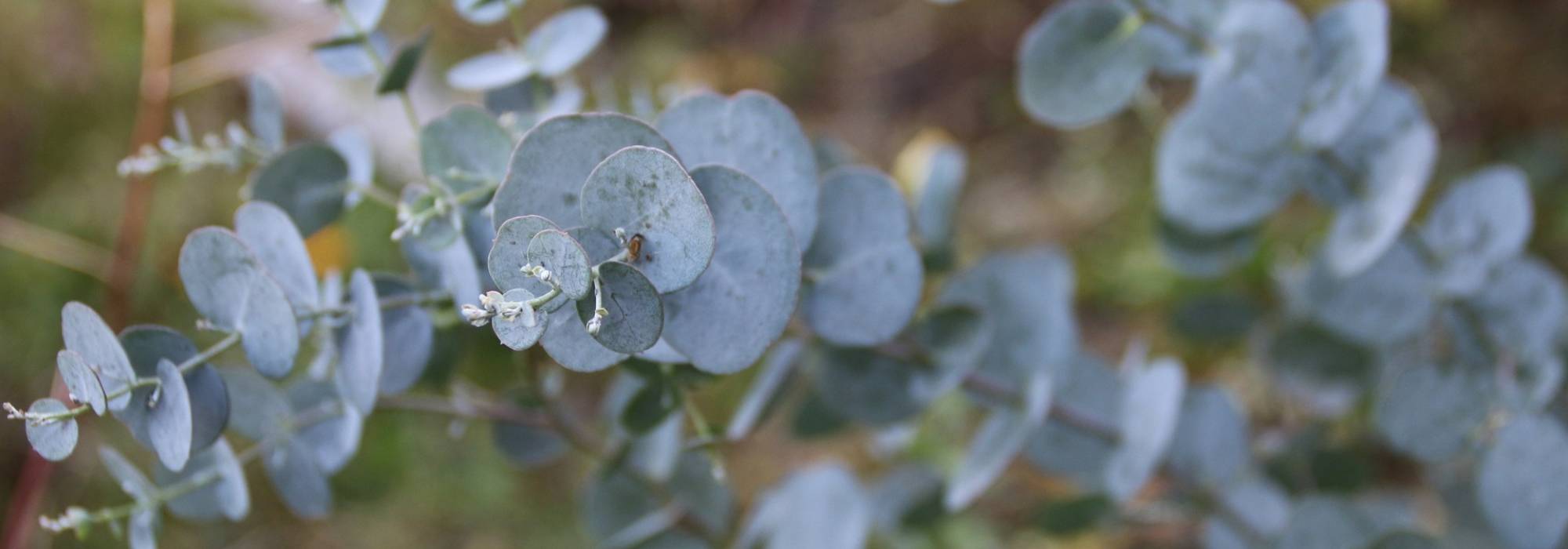
Eucalyptus: planting, pruning and care
Contents
Eucalyptus in a nutshell
- Eucalyptus is a tree or bush very decorative because of its bark and foliage
- With rapid growth, it grows tall and becomes a tree within a few years
- It is attractive both for its graceful silhouette, adorned with evergreen foliage often grey-blue, and the light shade it provides
- These low-maintenance trees are perfect for beginner gardeners: they are foolproof even in poor soil and withstand drought as well as excess water, provided information regarding their hardiness and pruning at maturity is taken into account
- Medicinal foliage provides an essential oil ideal for treating colds by inhalation
A word from our expert
Eucalyptus or gum tree, from bushy bush to large tree, is a plant with evergreen foliage and strongly aromatic scent. Eucalyptus wood is prized for its light tone and its robustness against insects despite the tree’s rapid growth. Native mainly to Australia, with hardiness varying by species, this essence is well adapted to our southern Atlantic or Mediterranean climates. Well known for disinfectant and decongestant medicinal properties for breathing passages (by inhalation, ingestion or application of essential oils), Eucalyptus is also an elegant tree, prized for beauty of its blue leaves in Eucalyptus gunnii, bright green or silvery-grey. Not forgetting decorative aspect of its coloured bark that peels in flakes, nor its flowering in pretty pom-poms of stamens that underline its membership of Myrtaceae family. One characteristic of Eucalyptus lies in dimorphism often observed between juvenile foliage, almost round, and adult leaves, lanceolate and narrow.
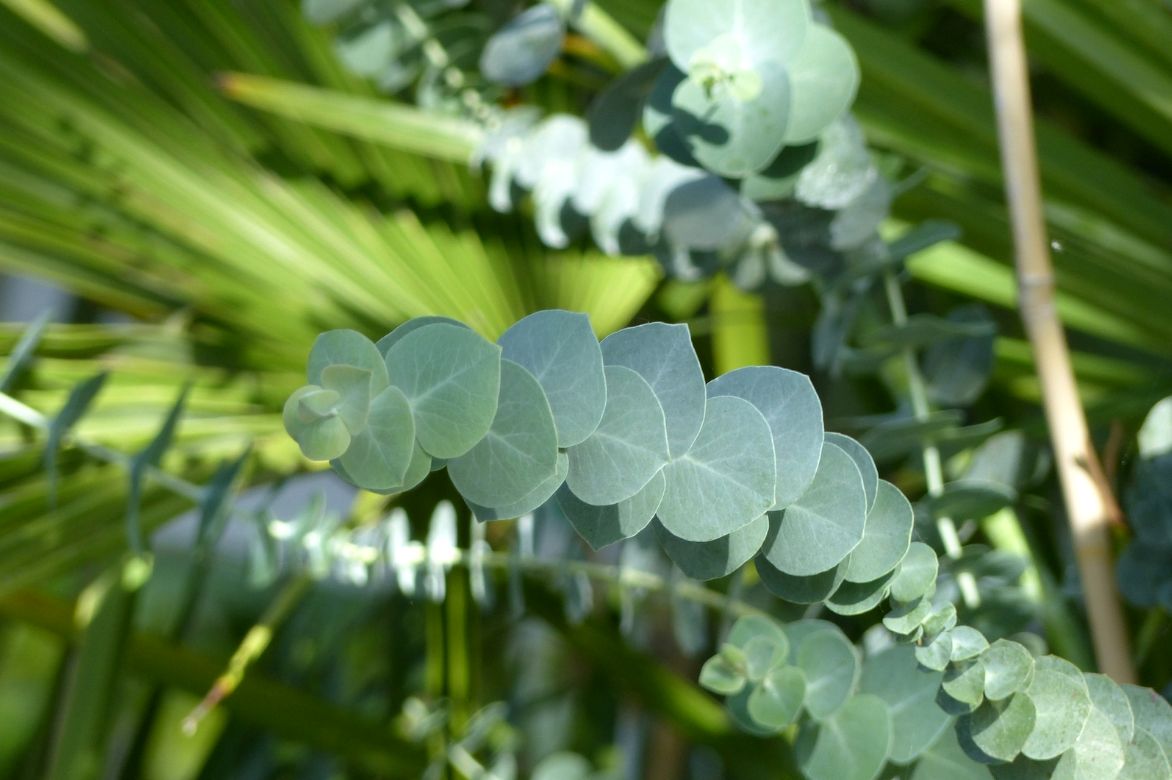
Small in size, Eucalyptus gunnii ‘Baby Blue’ can be grown in a pot
In garden, Eucalyptus are undemanding plants, chosen according to their soil preferences (moist, dry, calcareous, acid), hardiness, but also their development: take into account information regarding mature size of variety, because in two to three years growth can be spectacular! Eucalyptus is used as specimen, in a clump, as windbreak hedge or at back of a border. Its light touch, often silvery, its unexpectedly variegated pale bark and above all its rate of growth bring an undeniable exotic touch to a Mediterranean garden. Plant it beside drought-tolerant shrubs such as myrtles, cistus, Hakea, Leptospermum and Callistemon. Less vigorous species grow very well in containers, bringing a modern touch with their graphic habit and metallic colouring.
Eucalyptus, which enjoys continuous growth and a deep root system, is very water-demanding and capable of drying out marshes while also able to withstand drought. It has been widely planted in subtropical and tropical zones notably to fight malaria transmitted by mosquitoes but also to combat soil erosion, to supply pulp mills and to serve as fuel.
Description and botany
Botanical data
- Latin name Eucalyptus
- Family Myrtaceae
- Common name Eucalyptus, Gum
- Flowering very variable
- Height between 60 cm and 50 m in cultivation
- Exposure sun
- Soil type any deep soil, even poor; acid to calcareous depending on species
- Hardiness variable
Les Eucalyptus are trees or bushes originating from a relatively restricted area of the globe despite the impressive number of species—more than 600—and their almost worldwide distribution. Native primarily to the Australian continent – with a few species from southern Papua New Guinea, south-east Indonesia and southern Philippines – Eucalyptus today represents one of the main introduced tree taxa, notably in the dry tropical and subtropical regions of South America, Africa, India and the Middle East. These trees have the advantage of growing very quickly even on poor, degraded soils, which is why they are used in areas affected by desertification. Their multiple uses, whether for construction, fuel or pulpwood, contribute to their success, as does their undeniable ornamental appeal. At one time they were even thought to rival the sequoias for height—perhaps 135 to 150 m—but today no living specimen can testify to such records, victims of massive exploitation in the late 19th century. Eucalyptus regnans, known as the “mountain ash” because the wood grain resembles that of ash, reigns supreme in Victoria in Australia’s far south, approaching 120 m in height. The genus, which appeared in the Mesozoic era, predates the lime and plane trees by a few million years.
Eucalyptus belong to the family Myrtaceae along with myrtle and Callistemon (bottlebrush). They are generally tall, slim trees (e.g. E. gunnii), sometimes with a spreading crown as in E. pauciflora ssp. niphophila which can reach 6 m wide and 6–8 m high, or else with a bushy habit. Twigs and trunks may be twisted, highlighting their variegated or striped bark as in E. viminalis or E. urnigera, due to peeling in plates or strips.
Eucalyptus deglupta, nicknamed Rainbow Tree and unsuitable for frosty winters, displays very attractive vertically striated bark richly coloured. The trunk sometimes appears completely smooth and immaculate white after strips of bark fall away, as in Eucalyptus neglecta, or with a rough, caramel-sugar appearance as in E. sideroxylon ‘Rosea’. Size of eucalyptus in cultivation ranges from 60 cm to more than 70 m tall, with up to 10 m girth in E. globulus. Low-vigour forms are of course recommended for small gardens, such as E. pauciflora which reaches around ten metres; Eucalyptus gunnii ‘France Bleue Rengun’ is ideal in a pot or for a small garden, its height rarely exceeding 2 m. Growth is generally rapid due to the absence of growth dormancy during winter. Some species form a lignotuber (tuberised root) allowing the tree to resprout after fire.
All eucalyptus taxa have an aromatic evergreen foliage rich in essential oils contained in tiny translucent glands, which has earned them a reputation as medicinal plants. Young smooth shoots sometimes show a pretty red tint that contrasts with silvery foliage as in Eucalyptus pauciflora ssp. niphophila. Leaves are often dimorphic, changing shape as the plant ages. Young eucalypts such as E. gunnii or E. globulus have round or rectangular, opposite, sessile leaves that later become sickle-shaped, 5–45 cm long, and alternate. The upper canopy often bears adult leaves while the lower parts retain juvenile foliage. Frequent pruning helps keep juvenile foliage, which is prized in floral art. The fairly coriaceous lamina ranges from olive green to silvery, more or less bluish depending on species but also on age and environmental conditions. Veins are barely visible. Adult, pendulous leaves offer little surface to sun rays, limiting evapotranspiration. They are regularly renewed by abscission of shoot tips, so these twigs and pieces of bark can be collected for fuel. When wounded, the trunk exudes a resin sometimes red, hence the name gum, which is sometimes used as a polish.
The flowering period is extremely variable by species; it may be absent outside native habitat as in Eucalyptus gunnii and may occur all year round as in E. parvula. Flowering does not occur before five years of age. Flowers are highly melliferous, apetalous, spherical, formed of a multitude of stamens protected by an operculum that pops off at anthesis. Tightly packed stamens open like pompoms in white, cream but also orange, bright pink to red in some clones of E. ficifolia, E. leucoxylon and E. sideroxylon ‘Rosea’. They open among the leaves, often grouped along the twigs, and are followed by the formation of large green conical fruits that turn brown at ripeness. These capsules contain many very fine seeds dispersed by wind after about a year. They are also prized in floral art.
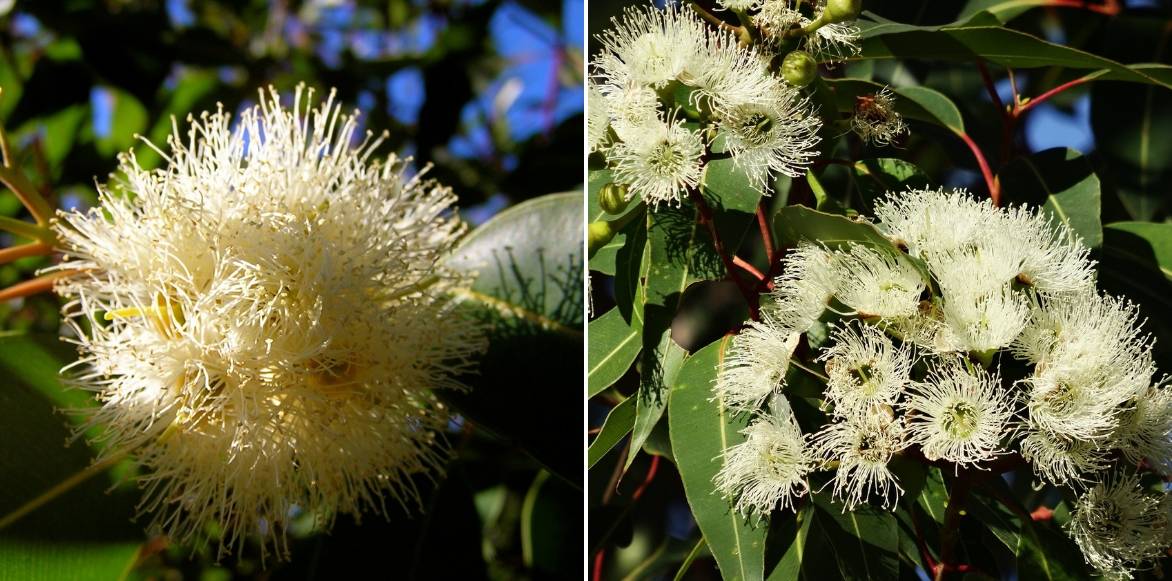
Eucalyptus flowers: E. gunnii ‘France Bleue Rengun’ and E. parviflora
The latex of the cider gum (E. gunnii) was consumed as a sweet drink by Aboriginal people, while the gum-resin of the ghost gum (E. papuana) was used as a powerful antiseptic. E. viminalis provided a sweet substance. Water was extracted from roots of species in arid zones to quench thirst. Leaves rich in essential oils from the cider gum are used in various forms (infusion, tincture, oil, …) to treat many respiratory ailments, rheumatism, migraines, fatigue and as an antiseptic. Different eucalyptus species with menthol, lemon or camphor scents provide varied therapeutic effects, from powerful anti-inflammatory and mosquito-repellent properties (E. citriodora) to antiviral, expectorant and anticatarrhal effects (E. radiata).
Eucalyptus wood, pale pink to light reddish-brown, varies in quality by species. It has a distinct sapwood and a fairly coarse grain that makes drying difficult, with a tendency to split and warp. Its durability ranges from moderately durable to durable, but it resists insect attacks except from termites. Eucalyptus marginata (jarrah) and E. diversicolor are among the most durable, with very hard wood used for shipbuilding, railway sleepers and garden furniture.
Juvenile foliage of Eucalyptus gunnii, E. globulus, E. cinerea as well as the fruits are prized in floral art.
Main varieties of Eucalyptus
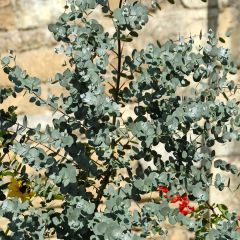
Cider gum - Eucalyptus gunnii
- Flowering time October
- Height at maturity 20 m
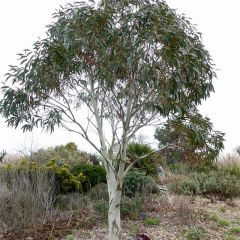
Eucalyptus pauciflora subsp. niphophila
- Flowering time June, July
- Height at maturity 7 m
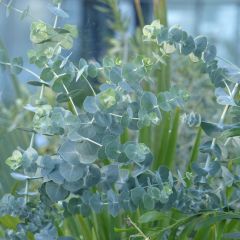
Eucalyptus pulverulenta Baby Blue (Little Boy Blue)
- Flowering time June, July
- Height at maturity 2,50 m
Discover other Eucalyptus
View all →Available in 1 sizes
Available in 1 sizes
Available in 1 sizes
Available in 1 sizes
Available in 1 sizes
Available in 1 sizes
Available in 1 sizes
Available in 2 sizes
Available in 1 sizes
Available in 1 sizes
Planting
Where to plant Eucalyptus?
Ideal climate for Eucalyptus is coastal or southern France, where frosts are mild and short-lived. Yet, looking closer, Ireland or Brittany can host magnificent specimens under much less sunny, cooler and damper conditions, sheltered from winds.
Choose a well-drained soil, from fresh to dry, and a warm, sunny position, sheltered from strong, cold winds. Eucalyptus pauciflora subsp. niphophila does not much like calcareous soils, whereas E. gunnii and E. dalrympleana are indifferent. Hardiness of species is quite variable: snow gum Eucalyptus pauciflora subsp. niphophila is among hardiest, tolerating temperatures below -18°C and not fearing snow. E. gunnii ‘Azura’ tolerates -14 to -18°C; E. parvula, with foliage reminiscent of an olive, and E. viminalis also tolerate frosts down to -15°C. In most of our regions, plant them in open ground, improving drainage with additions of coarse sand, pumice or non-calcareous gravel. Dwarf cultivars such as Eucalyptus pulverulenta ‘Baby Blue’ or E. gunnii ‘France Bleu Rengun’ hardly tolerate temperatures below -10°C but can be brought indoors into a cool, bright room for maximum frost protection and be pruned every year in March–April. Planting in a container also ensures moderate growth.
Gum trees are useful for drying out wet ground, as they are heavy consumers of water even in winter. However, they are drought-resistant once well established and generally do very well in Mediterranean-type climates.
When to plant?
Eucalyptus is best planted in early spring to avoid exposing it to winter cold, unless climate is dry and warm.
How to plant?
Prefer planting young plants which cope better with transplanting stress.
- Dig planting hole about 50 cm in all directions.
- Add a 20 cm drainage layer (gravel, coarse sand, pumice…) if soil is heavy and severe frosts are a risk.
- For a large-growing tree, drive 4 stakes 8 cm in diameter around the hole, to be attached to the trunk with soft ties.
- Place the rootball so as not to bury the collar.
- Backfill the hole and firm lightly.
- Water thoroughly to remove air pockets.
- Place soft ties to stake it without risking damage to the trunk.
Establishment is easy and rapid and only requires monitoring of watering during first two years after planting.
In windy coastal regions such as Brittany, a useful tip is to plant the eucalyptus above a fairly large rock so the roots can grow around it. This strengthens anchorage of the tree which, equipped with a taproot and an imposing crown, can sometimes be uprooted by strong gusts. Then leave nature to take its course; formal training of the tree is unnecessary.
Choose a pot large and deep enough, filled with a substrate that is both light and rich.
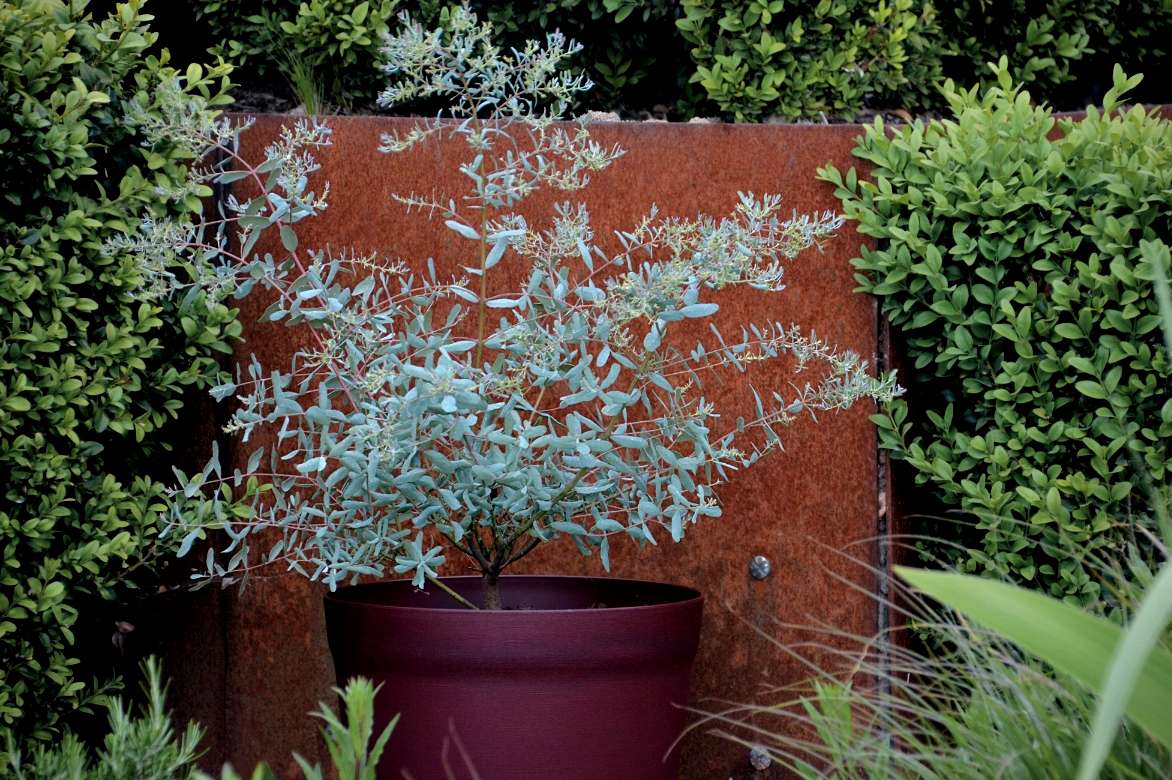
Eucalyptus gunnii ‘France Bleu Rengun’ grown in a pot
→ Discover our care sheets: Eucalyptus — how to protect from cold in winter? and Growing eucalyptus in a pot
Pruning and care
Water regularly for the first two years during summer, then the plant will need no care once well established in open ground. However, take care with watering potted Eucalyptus by letting the growing medium dry out at the surface between waterings, as its roots cannot penetrate deeply to draw water. You can overwinter it in a cold greenhouse or in an unheated, bright room, like oleander.
Eucalyptus pruning
If severe frost scorches the shoots, do not worry: a cut back to ground level often encourages rapid regrowth. Make sure to select 1 to 3 stems to reform a tree. Some gardeners prefer to maintain a handsome, bushy shrub about 3 m high by systematically cutting back in March. Be careful not to inflict large pruning wounds! You can also cut some large roots to reduce vigour. In general, Eucalyptus does not require pruning. Simply remove small branches from the trunk to give it a smooth appearance and clear twigs from within the crown while the tree is still young.
Read also: How to prune an Eucalyptus?
Capable of drawing water and mineral salts from depth, eucalyptus needs nothing to develop — let nature take its course. For low-vigour varieties grown in containers, occasionally add compost or potting soil as a top dressing in autumn.
Potential parasitic pests
Eucalyptus is naturally fairly resistant to diseases and pests. Eucalyptus gall sometimes occurs in Mediterranean regions, caused by the sting of a small wasp Ophelimus eucalypti, which makes the leaves yellow. Prune out affected foliage promptly.
→ Find out more about Eucalyptus diseases and pests with Gwenaëlle!

Eucalypts display beautiful decorative bark
Multiplication
Sowing is the most commonly used method to propagate eucalyptus. However, it is delicate because seeds are very small and require adequate heat and humidity to germinate.
Sowing
- Keep them for one month below 4°C, then sow just below the surface in a bucket wrapped in a freezer bag and place between 22 and 25°C in full light.
- As soon as germination occurs, after about one week, move the bucket to 20°C.
- When seedlings have four leaves, transplant all into a larger pot without disturbing the rootball and remove weakest young plants. Gradually open the bag and place above 20°C in a location sheltered from direct sunlight.
Uses and companion plants
Eucalyptus with grey-blue foliage work wonders in white- or silver-dominated schemes, adding metallic sheen and sound as breeze moves the foliage. Eucalyptus can form a large curtain windbreak that nevertheless lets light filter through, in contrast with dark green of Provence cypress, for example. It brings a undeniable touch of exoticism to garden whether planted in groups, singly or alongside bush species from southern lands. Feel free to mix specimens of Hakea, Leptospermum and Callistemon with our Mediterranean garrigue essential oils such as myrtles, Arbutus, cistus, Phlomis and rosemary.
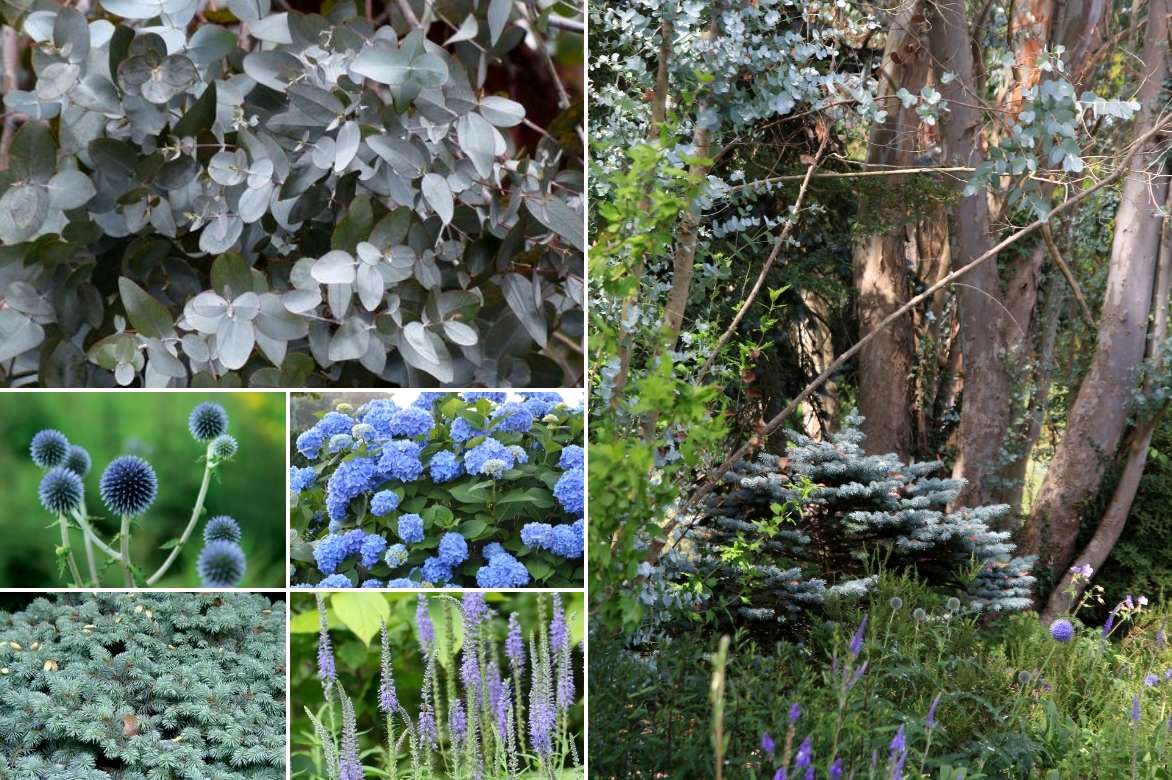
An example of tone-on-tone pairing: Eucalyptus gunnii, Echinops ritro, Hydrangea macrophylla ‘Endless Summer The Original’, Picea pungens ‘Glauca Globosa’, Veronica longifolia ‘Blauriesen’
Bluish metallic tone, graphic quality and transparency of foliage of a specimen placed on balcony or terrace bathe scene in soothing softness. If pruned very short repeatedly, silhouette becomes denser and can showcase bright flowering of bedding plants (geraniums, dahlias, impatiens…) but it will lose a little of its soul. These bushes have advantage of being elegant at every stage of their growth, young or mature.
Eucalypts with ramified silhouette and little sensitive to frost such as niphophila can slip into an informal hedge of fairly hardy bushes with a southern feel, such as Buddleia ‘Lochinch’, ‘Bicolor’ and oleanders ‘Luteum Plenum’, ‘Provence’, ‘Atlas’. But a specimen as remarkable as mountain gum equally deserves a place on its own, because of its tortured habit, its bark and elegant foliage.
→ Discover more ideas for pairing with Eucalyptus with Alexandra!
History of Eucalyptus
Discovery of Eucalyptus verges on miraculous. A storm forced two ships that had sailed from Brest in search of a vessel lost in the Southern Ocean three years earlier to anchor off Tasmania towards the end of the 18th century. On-board botanists then discovered an immense tree, Eucalyptus globulus, which would be forgotten except by a few enlightened collectors. Widespread planting resulted from intuition of Mueller, a Danish naturalist settled in Australia, and Ramel, a French merchant, convinced of tree’s value.
Eucalyptus, which enjoys continuous growth and a deep root system, has high water demand and is capable of drying out marshes to combat malaria transmitted by mosquitoes while also being able to resist drought. They therefore sent seeds across Europe so it could be acclimatised. Eastern Corsica benefited quickly and by about 1875 success was such that 4 million trees were planted in Algeria and 200 000 in Egypt. Spain and Portugal, which planted it in wet areas (Cantabrian Coast…) to limit soil erosion and for paper-pulp manufacture, are today less enthusiastic because of ecological consequences of this introduction.
Nothing grows beneath it because of its allelopathic power, even though light easily penetrates through its pendulous leaves. Its cultivation leads to drying up of water tables; eucalyptus is an active pyrophyte. It emits highly flammable vapours. Fire spreads quickly, unlike in holm oak and cork oak forests, the first protected by absence of herbaceous understorey due to darkness, the second protected by fire-retardant bark.
To learn more
Discover our wide range of Eucalyptus.
Discover how to choose an Eucalyptus in our article and which Eucalyptus to plant for your region
They withstand cold: discover the hardiest Eucalyptus and how to protect your Eucalyptus from winter cold
Read Sophie’s advice sheet: 7 trees for seaside gardens and other trees that grow well in full sun
Also read our article on the Best long-lasting flowers and foliage for your bouquets
Eucalyptus is one of the effective anti-moth plants: discover how to use it for that purpose.
Frequently asked questions
-
How to prune eucalyptus?
People are often surprised by how large Eucalyptus gunnii can get. You can cut back the trunk and branches provided you do so regularly, every 1 or 2 years, to avoid inflicting large wounds. Carry out pruning in March–April or in September if the climate is mild. The numerous shoots will then form a clump with rounded juvenile foliage.
An exceptional frost sometimes affects large trees, causing much of the tree to die back. In that case, make a clean cut just above the living wood so as not to destroy mechanical and chemical barriers the tree has established at its core. Then select 1 to 3 shoots to reform one or more trunks.
If you need to remove an awkward, broken or diseased branch, prune at an angle just beyond the swelling (neck) at the branch base, which can be several centimetres on eucalyptus. This will ensure good healing of the wound.
- Subscribe!
- Contents
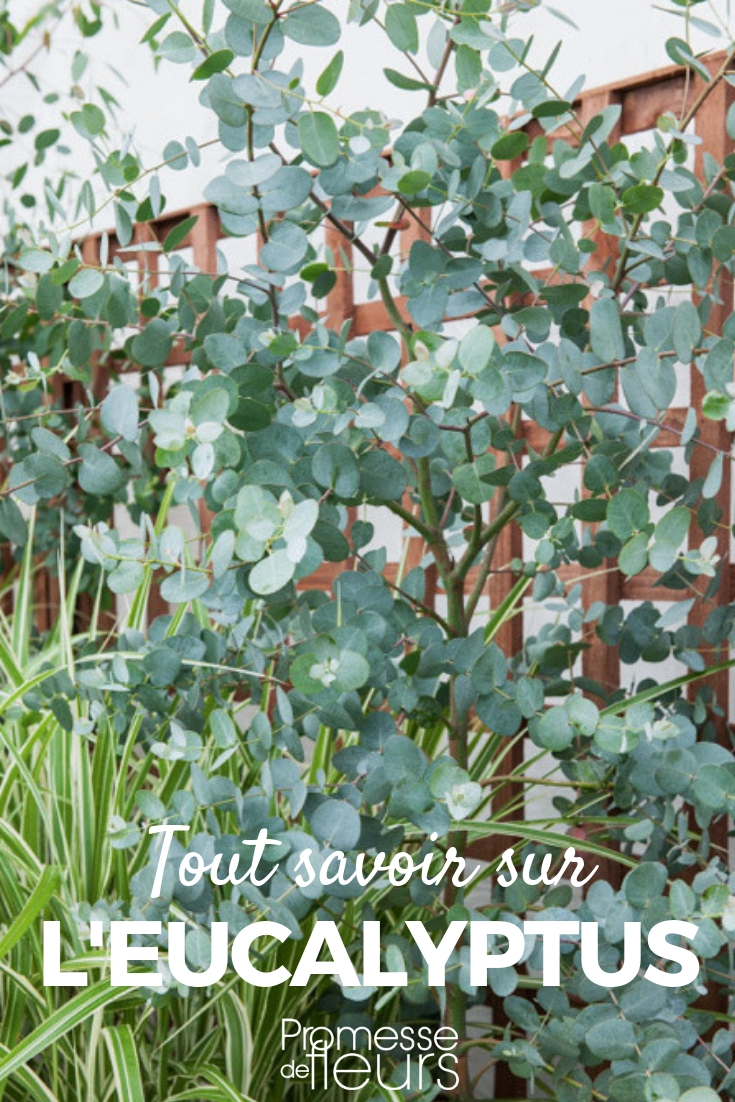































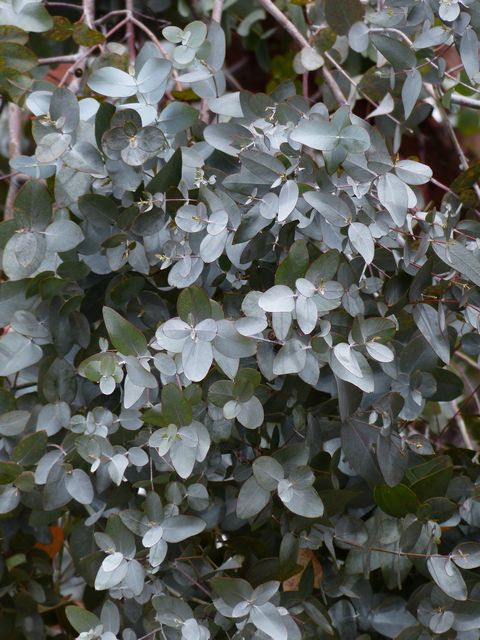
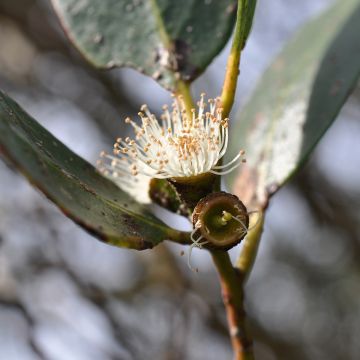

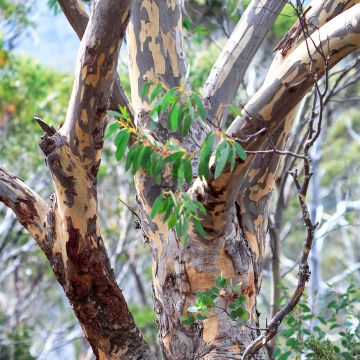
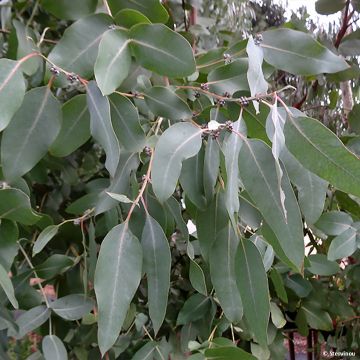
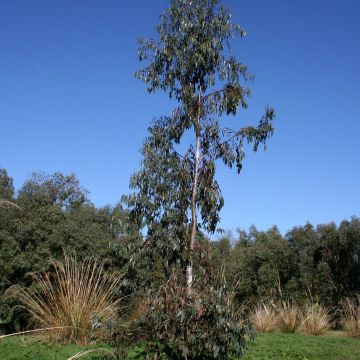
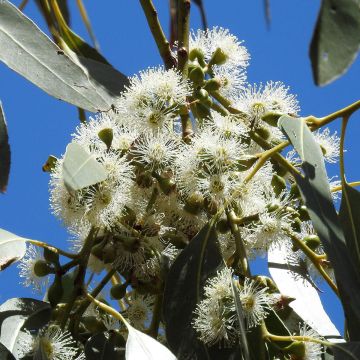
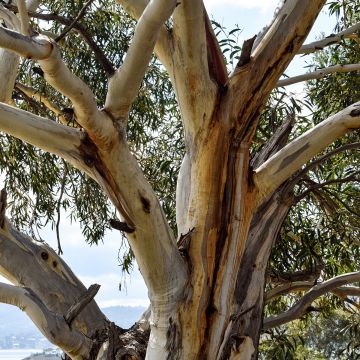
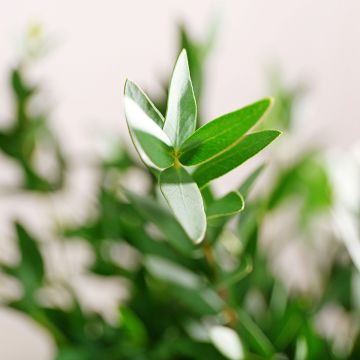
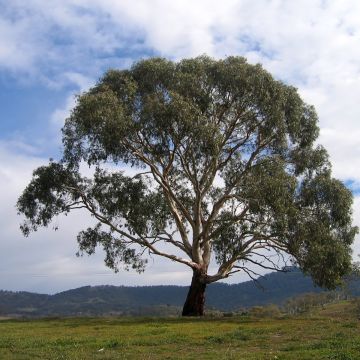
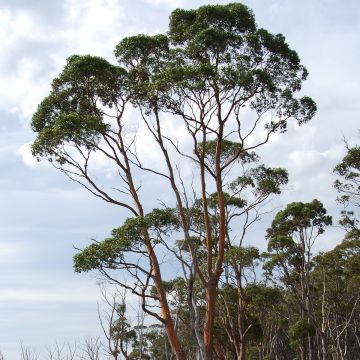
Comments